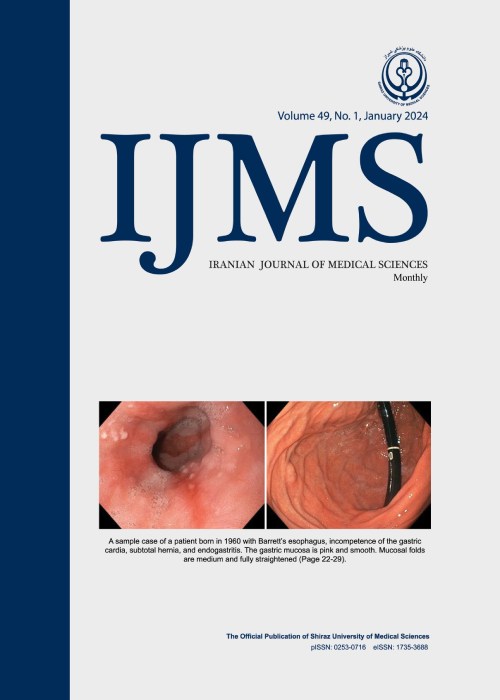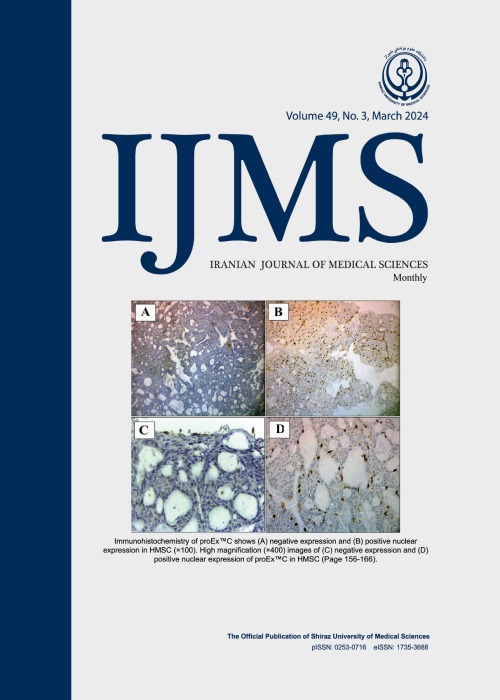فهرست مطالب

Iranian Journal of Medical Sciences
Volume:49 Issue: 1, Jan 2024
- تاریخ انتشار: 1402/10/11
- تعداد عناوین: 8
-
-
Pages 1-9
Monkeypox is an infectious and contagious zoonotic disease caused by the Orthopoxvirus species and was first identified in Africa. Recently, this infectious disease has spread widely in many parts of the world. Fever, fatigue, headache, and rash are common symptoms of monkeypox. The presence of lymphadenopathy is another prominent and key symptom of monkeypox, which distinguishes this disease from other diseases and is useful for diagnosing the disease. This disease is transmitted to humans through contact with or eating infected animals as well as objects infected with the virus. One of the ways to diagnose this disease is through PCR testing of lesions and secretions. To prevent the disease, vaccines such as JYNNEOS and ACAM2000 are available, but they are not accessible to all people in the world, and their effectiveness and safety need further investigation. However, preventive measures such as avoiding contact with people infected with the virus and using appropriate personal protective equipment are mandatory. The disease therapy is based on medicines such as brincidofovir, cidofovir, and Vaccinia Immune Globulin Intravenous. The injectable format of tecovirimat was approved recently, in May 2022. Considering the importance of clinical care in this disease, awareness about the side effects of medicines, nutrition, care for conjunctivitis, skin rash, washing and bathing at home, and so on can be useful in controlling and managing the disease.
Keywords: Disease management, Monkeypox, Communicable diseases, Therapeutics -
Expression and Clinical Significance of IRE1-XBP1s, p62, and Caspase-3 in Colorectal Cancer PatientsPages 10-21Background
Three main cell signaling pathways including the endoplasmic reticulum stress (ERS) response, autophagy, and apoptosis play critical roles in both cell survival and death. They were found to crosstalk with one another during tumorigenesis and cancer progression. This study aimed to investigate the expression of the spliced form of X-box binding protein 1 (XBP1s), p62, and caspase-3, as the essential biomarkers of ERS, autophagy, and apoptosis in patients with colorectal cancer (CRC), as well as the correlation between their expression and clinicopathological data.
MethodsThis retrospective study was conducted on formalin-fixed paraffin-embedded (FFPE) blocks, which were collected from patients and their tumor margins, from the tumor bank of Imam Khomeini Hospital (Tehran, Iran) from 2017 to 2019. Tissue microarray (TMA) was used to measure the XBP1s, p62, and caspase-3 biomarkers. Data were analyzed using SPSS software version 20, and P≤0.05 was considered statistically significant.
ResultsEvaluating the total of 91 patients, a significant relationship was found between XBP1s expression and TNM stage (P=0.003), primary tumor (pT) (P=0.054), and the degree of differentiation (P=0.006); and between caspase-3 with pT (P=0.004), and lymphovascular invasion (P=0.02). However, no significant correlation was found between p62 and clinicopathological data. Furthermore, a positive relationship between XBP1s and p62 was confirmed (correlation coefficient: 22.2% and P=0.05).
ConclusionOur findings indicated that XBP1s could be considered as a target for therapy in personalized medicine.
Keywords: apoptosis, Autophagy, Caspase-3, Colorectal neoplasm, endoplasmic reticulum stress -
Pages 22-29BackgroundSurgical treatment of recurrent gastroesophageal reflux disease (GERD) negatively affects patients’ quality of life (QoL). Determination of risk factors is essential when considering a surgical approach. The present study aimed to evaluate short-term and long-term outcomes of primary laparoscopic Nissen fundoplication (LNF) and open Nissen fundoplication (ONF), as well as the risks of laparoscopic redo fundoplication.MethodsA retrospective cohort observational study was conducted from 2010 to 2021 at the National Research Center of Surgery (Almaty, Kazakhstan). Depending on the type of primary GERD surgical correction, 475 patients were stratified into two groups, namely LNF (n=117) and ONF (n=358). The outcomes and associated complications of LNF and ONF surgeries were assessed. The odds ratio of recurrent GERD in terms of risk factors was analyzed as well as post-intervention QoL.ResultsPostoperative complications in ONF surgery were 2.7-fold higher than in LNF (P=0.0001). Moreover, intra-operative complications were higher with ONF surgery (7.7%) than with LNF (1.4%) (P=0.002). In cases with persistent clinical manifestations, the rate of redo fundoplication was the same after failed primary LNF and ONF. The risk factors associated with recurrent GERD, leading to redo fundoplication, were obesity (OR=2.16, P=0.473) and male sex (OR=3.0, P=0.272). One-year after LNF, 88.7% of the patients were satisfied with the outcome of the surgery.ConclusionRecurrent symptoms of GERD and the rate of redo fundoplication were associated with obesity and the male sex. Obesity was the main risk factor, necessitating stringent selection of patients for surgical management of the disease.Keywords: Gastroesophageal reflux, General Surgery, Fundoplication, Laparoscopy, Esophagoplasty
-
Pages 30-39BackgroundHerbal medicines are the preferred anticancer agents due to their lower cytotoxic effects on healthy cells. Plant lignans play an important role in treating various diseases, especially cancer. The present study aimed to evaluate the effect of podophyllotoxin, pinoresinol, and lariciresinol on cellular toxicity and inducing apoptosis in fibroblasts, HEK-293, and SkBr3 cell lines.MethodsAn in vitro study was conducted from 2017 to 2019 at the Faculty of Biological Sciences, Tarbiat Modares University (Tehran, Iran). The cell lines were treated for 24 and 48 hours with different concentrations of lignans. Cell viability and apoptosis were examined using MTT and flow cytometry, respectively. Expression levels of cell cycle and apoptosis regulator genes were determined using quantitative real-time polymerase chain reaction. Data were analyzed using a two-way analysis of variance followed by Tukey’s HSD test. P<0.05 was considered statistically significant.ResultsPodophyllotoxin significantly increased apoptosis in fibroblast cells compared to pinoresinol and lariciresinol (P<0.001). The percentage of cell viability of fibroblast cells treated for 48 hours with pinoresinol, lariciresinol, and podophyllotoxin was reduced by 49%, 47%, and 36%, respectively. Treatment with pinoresinol and lariciresinol significantly overexpressed pro-apoptotic genes and underexpressed anti-apoptotic genes in SkBr3 cells (P<0.001). SkBr3 cells treated with lariciresinol significantly reduced gene expression (P<0.001).ConclusionPinoresinol and lariciresinol can potentially be used as new therapeutic agents for the treatment of breast cancer.Keywords: Lignans, Natural products, Breast neoplasms, Cell Viability, apoptosis
-
Pages 40-45BackgroundEpidemic thunderstorm asthma is an observed increase in cases of acute bronchospasm following thunderstorms. This study aimed to compare the frequency of obstructive airway disease or bronchial hyperresponsiveness in subjects with thunderstorm-associated respiratory symptoms with subjects with similar symptoms presented at other times.MethodsA cross-sectional study from June to November of 2013 was conducted on subjects with thunderstorm-associated respiratory symptoms living in Ahvaz City, Iran. Thunderstorm-associated subjects were presented with asthmatic symptoms in thunderstorms, and other patients presented with similar symptoms at other times. Baseline spirometry was performed on patients to examine the presence of obstructive airway disease. In all patients with normal spirometry, a provocation test was applied. A comparison of qualitative and quantitative variables was made using the Chi-square and independent t test, respectively. All analyses were carried out using SPSS Statistics Version 22. A P value less than 0.05 was considered statistically significant.ResultsOut of 584 subjects, 300 and 284 participants were in thunderstorm-associated and non-thunderstorm-associated groups, respectively. After the final analysis, 87 (30.6%) and 89 (33.3%) of the thunderstorm-associated subjects and non-thunderstorm-associated group, respectively, had pieces of evidence of airflow limitation (P=0.27). Among the patients with normal spirometry, 161 (81.72%) of the thunderstorm-associated patients and 100 (56.17%) patients of the non-thunderstorm-associated symptoms group had a positive methacholine challenge test result (P<0.001).ConclusionMost of the patients with thunderstorm-associated respiratory symptoms had no obvious evidence of airflow limitation in spirometry.Keywords: Asthma, Spirometry, Thunderstorm, Methacholine chloride, Respiratory function tests
-
Pages 46-56Background
Letrozole, an aromatase inhibitor, has recently been introduced as the preferred treatment option for ectopic pregnancy. To date, no study has investigated the effect of letrozole alone on placental tissue. The present study aimed to evaluate the effect of different doses of letrozole on the placenta of rats and to clarify the underlying mechanism.
MethodsSixty pregnant female rats were equally divided into three groups, namely the control group (GI), low-dose (0.5 mg/Kg/day) letrozole group (GII), which is equivalent to the human daily dose (HED) of 5 mg, and high-dose (1 mg/Kg/day) letrozole group (GIII), equivalent to the HED of 10 mg. Letrozole was administered by oral gavage daily from day 6 to 16 of gestation. Data were analyzed using a one-way analysis of variance followed by Tukey’s post hoc test and Chi square test. P<0.05 was considered statistically significant.
ResultsCompared to the GI and GII groups, high-dose letrozole significantly increased embryonic mortality with a high post-implantation loss rate (P<0.001) and significantly reduced the number of viable fetuses (P<0.001) and placental weight (P<0.001) of pregnant rats. Moreover, it significantly reduced placental estrogen receptor (ER) and progesterone receptor (PR) (P<0.001) and the expression of vascular endothelial growth factor (P<0.001), while increasing the apoptotic index of cleaved caspase-3 (P<0.001).
ConclusionLetrozole inhibited the expression of ER and PR in rat placenta. It interrupted stimulatory vascular signals causing significant apoptosis and placental vascular dysfunction. Letrozole in an equivalent human daily dose of 10 mg caused a high post-implantation loss rate without imposing severe side effects.
Keywords: Letrozole, Placenta, Receptors, Estrogen, Progesterone, Vascular endothelial growth factor, Caspase -
Pages 57-61
Following the initial liver biopsy attempts, several techniques using a wide range of methodologies and materials were developed. Many studies on the evaluation of post-liver biopsy complications were conducted. However, their fundamental limitation was significant variance in patient demographics and methodology, which might account for the inconsistent outcomes. Therefore, a uniform methodology to perform percutaneous liver biopsies that result in comparable outcomes around the world is required. This study aimed to determine the precise complication rate following percutaneous liver biopsy using a consistent method in all individuals. It also aimed to establish a consistent operating procedure for a percutaneous liver biopsy that yielded comparable outcomes. Between July 2018 and July 2019, 116 patients were enrolled in this retrospective study for percutaneous liver biopsy. All individuals underwent a biopsy using the same procedure. There was an attempt to exclude elements that could have an impact on the complication rate. For this purpose, the same type and size of needle were utilized. Moreover, a single needle pass, a subcostal approach, deep inspiration breath holding, identical pre- and post-biopsy preparation, real-time ultrasonography guidance, the use of a single operator, and the absence of sedation or general anesthesia were the other approaches that were used to minimize the impact of variables that could raise complication rates. The overall complication rate was 19.8%, of which 18.9% of patients experienced pain and mild bleeding, and one patient (0.9%) experienced hematoma necessitating precautionary hospitalization. The overall percentage of patients who experienced pain was 13.8%. No further complications were observed. The findings of this study could provide an accurate estimate of the post-liver biopsy complication rate. Furthermore, due to a lower complication rate than other practiced procedures, this uniform methodology could be an attractive alternative in clinical practice. However, more research is required to confirm these results.
Keywords: Biopsy, Ultrasonography, Liver, Bleeding, Postoperative complications -
Pages 62-64
Despite substantial advancements in disease management, contagious diseases continue to be important in epidemiology and public health.
Keywords: COVID-19, Spatial behavior, Disease hotspot, Supply, distribution, Iran


